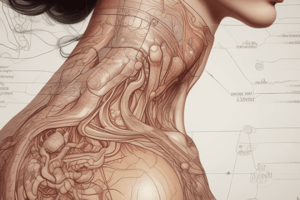Podcast
Questions and Answers
Which layer of the skin contains smooth muscle, hair follicles, and sebaceous glands?
Which layer of the skin contains smooth muscle, hair follicles, and sebaceous glands?
- Dermis (correct)
- Deep Fascia
- Epidermis
- Superficial Fascia
What is the primary function of the epidermis?
What is the primary function of the epidermis?
- Protection (correct)
- Regulating temperature
- Providing nourishment
- Forming Vit D
Which of the following statements about lines of cleavage (Langer's lines) is true?
Which of the following statements about lines of cleavage (Langer's lines) is true?
- They guide the direction for surgical incisions. (correct)
- They are arranged randomly across the skin.
- They are found only in the epidermis.
- They indicate areas where blood vessels are sparse.
Which structure is primarily responsible for the involuntary movement of hair and secretion from sebaceous glands?
Which structure is primarily responsible for the involuntary movement of hair and secretion from sebaceous glands?
What is NOT a function of the skin?
What is NOT a function of the skin?
What is the primary function of sebum secreted by the sebaceous gland?
What is the primary function of sebum secreted by the sebaceous gland?
Where do apocrine sweat glands primarily function?
Where do apocrine sweat glands primarily function?
Which structure primarily facilitates movement of the skin over underlying structures?
Which structure primarily facilitates movement of the skin over underlying structures?
The duct of the sebaceous gland opens primarily into which part of the hair structure?
The duct of the sebaceous gland opens primarily into which part of the hair structure?
Which type of sweat gland has a distinctive odor and becomes active at puberty?
Which type of sweat gland has a distinctive odor and becomes active at puberty?
Flashcards are hidden until you start studying
Study Notes
Function of the Skin
- The largest organ in the body
- Protects the body from the external environment
- Excretes waste products like sweat
- Absorbs substances like medications
- Regulates body temperature
- Produces vitamin D
- Provides sensation
Structure of the Skin
- Composed of two layers: the epidermis and the dermis
The Epidermis
- Superficial layer of the skin
- Composed of flat cells filled with keratin
- The deep layer has cells that regenerate
- Avascular, but contains sensory nerve endings
### The Dermis
- Deep layer of the skin
- Composed of connective tissue
- Contains:
- Blood vessels
- Lymph vessels
- Sensory nerve endings
- Smooth muscle
- Hair follicles
- Sweat glands
- Sebaceous glands
Lines of Cleavage (Langer's Lines)
- Collagen fibers in the deep part of the dermis are arranged in parallel rows
- Longitudinally in limbs, circumferentially in the neck and trunk
- Important to consider during surgery to minimize scarring
Skin Appendages
- Hairs:
- Root embedded in the skin
- Shaft projects on the surface
- Hair follicle formed by the root and surrounding epidermal cells
- Arrector pili muscle:
- Band of smooth muscle innervated by sympathetic nerve fibers (involuntary)
- Contraction moves hair to a more vertical position and squeezes sebaceous gland
- Sebaceous Glands:
- Duct opens into hair follicle
- Secretes sebum (an oily material that softens the skin and lubricates the hair)
- Sweat Glands:
- Duct opens on the surface of the skin
- Secretes sweat
- Apocrine sweat glands:
- Located in axilla and external genitalia
- Function at puberty and secrete sweat with a characteristic odor
- Nails:
- Keratinized plate
- Located on the dorsal surface of the distal phalanx of the fingers and toes
The Fascia
- Connective tissue that surrounds and supports muscles and organs
- Two types: superficial and deep fascia
Superficial Fascia
- Loose, except in some areas (sole, palm, scalp)
- Functions:
- Bad heat conductor (keeps the body temperature)
- Gives the body smooth rounded appearance (particularly in females)
- Facilitates movement of the skin over the underlying structures
- Contains:
- Nerves
- Blood vessels
- Fat
- Muscles, like platysma
Deep Fascia
- Dense and usually forms membranes
- Forms special structures:
- Investing fascia
- Intermuscular septa
- Sheathes for neurovascular bundles
- Aponeurosis
- Functions:
- Gives attachment to some muscles
- Intermuscular septa prevent the spread of blood or pus
- Muscle pump helps venous return
- Retinacula hold tendons in place to facilitate the action of muscles
- Palmar and plantar aponeuroses protect the deep structures
The Muscles
- Red, fleshy, contractile tissue responsible for movement
- Three types: smooth, cardiac, skeletal
Smooth Muscle
- Location: wall of internal viscera and blood vessels
- Nerve supply: autonomic
- Contraction: involuntary
- Striations: absent
Cardiac Muscle
- Location: heart (myocardium)
- Nerve supply: autonomic
- Contraction: involuntary
- Striations: present
Skeletal Muscle
- Location: attached to the skeleton
- Nerve supply: somatic
- Contraction: voluntary
- Striations: present
Skeletal Muscles
- Definition: muscles attached to the skeleton to generate movement
- Parts of a skeletal muscle:
- Muscle belly: red fleshy contractile part between the two tendons
- Tendon: white fibrous non contractile part (rounded cord-like) or aponeurosis (flat sheet)
- Attachment:
- Origin: more fixed attachment
- Insertion: more mobile attachment
- Can be attached to: bone, cartilage, ligament, fascia, skin, other muscle
- Classification:
- Prime movers: initiate a particular movement
Studying That Suits You
Use AI to generate personalized quizzes and flashcards to suit your learning preferences.




